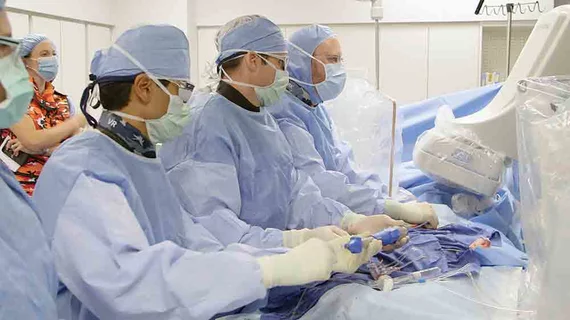Intermediate-risk transcatheter aortic valve replacement (TAVR) patients see fewer strokes, deaths and encephalopathies than those who undergo surgical aortic valve replacement (SAVR), researchers reported in the Oct. 30 edition of the Journal of the American College of Cardiology.
First author Andras P. Durko, MD, and colleagues said in the journal that as TAVR evolves as a treatment option for not just high-risk, but also lower-risk patients, physicians should be wary of the neurological risks that come with the procedure.
“Neurological events carry significant burden of disease with potential long-term consequences and substantial healthcare-related costs,” Durko, a PhD student at Erasmus University Medical Center in Rotterdam, the Netherlands, and co-authors wrote. “Neurological events after open heart surgery have long been a major concern because of their adverse effects on post-procedural quality of life and survival, potentially jeopardizing the overall positive results of the procedure.”
To assess patients’ safety after valve interventions, Durko and his team launched the SURTAVI trial, a study of 1,660 patients with severe aortic stenosis randomized 1:1 to either TAVR or SAVR. All patients were at an intermediate surgical risk.
Durko et al. found the rates of early (30-day) stroke and post-procedural encephalopathy were higher in SAVR versus TAVR patients (5.4 percent versus 3.3 percent and 7.8 percent versus 1.6 percent, respectively). Rate of stroke didn’t differ much at the one-year mark (6.9 percent versus 5.2 percent), though early stroke and early encephalopathy contributed to mortality hikes in both groups.
Quality of life was also significantly diminished in SAVR patients compared to their TAVR counterparts.
“The SURTAVI trial is the first randomized study showing a lower rate of early neurological events with TAVR (vs. SAVR), and the rigorous and systematic approach for assessing neurological outcomes undoubtedly represents its major strength,” Josep Rodés-Cabau, MD, and Ralph L. Sacco, MD, MS, wrote in a related JACC editorial. “These results, however, remain a secondary analysis of a noninferiority trial, and the relatively low number of events in both groups calls for some caution in their interpretation.”
Since reports comparing TAVR and SAVR outcomes have been so conflicting, Rodés-Cabau and Sacco said future research will need to solidify any link between TAVR and poor neurological health. They said it’ll be important for researchers to identify individual neurologic events, as well as account for several factors Durko’s team didn’t, like the fact that one-fifth of SAVR patients also underwent coronary bypass grafting, which could have influenced results.
“Neurological complications following AVR remain a major concern,” Rodés-Cabau and Sacco said. “Continuous efforts to identify modifiable predictors of neurological events and the implementation of protective measures need to remain one of the major research priorities in this field to advance the care of patients who need AVR."

